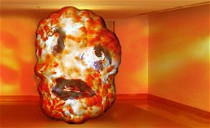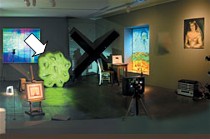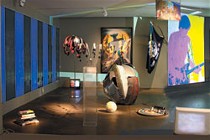Revenge of the couch potato

I’m still smarting from Tony Oursler’s social criticism in “Climaxed,” one of his two installations at the Metropolitan Museum of Art that I was going to dismiss before I even saw them (The lesson here is that images of art work lie). But then Murray and I saw them and remained engrossed in both of the pieces for quite a long time. So there. They are worth creeping around and finding in that step-child gallery of contemporary art (right, a detail of “Climaxed,” the orange flames extending around three walls).
“Climaxed,” a projected face floating in a room animated by a projected explosion, has the mesmerizing quality of lava lamps. The voice speaks in slightly garbled tongues that include such phrases as, “Boom,” “I’m the best motion picture” and “I’ve got you all in a coma and you don’t get that time back.” And the eyes operate independently from one another.
The face is on a shape that’s potato like, and it’s suggesting to us couch potatoes that we need to wean ourselves from the screens, small and large. The googly, goofy eyeballs seem to have watched far too much tv and far too many movies. Of course this is somewhat disingenuous given that “Climaxed” too is a video entertainment, explosive violence and all.
I’m not sure why we stood there and watched this for as long as we did. The words were funny and hard to hear, so we waited for more, straining to decode. But ultimately, I think it was a little of couch-potato-ism that kept us there. All that was missing was the couch.
Installation a clef

As much as I enjoyed “Climaxed,” it has not quite as much charm as the money shot over in the large installation, “Studio: Seven Months of My Aesthetic Education (Plus Some),” which was inspired by Gustave Courbet’s “The Artist’s Studio: A real allegory of a seven year phase in my artistic and moral life.” (image left, a view of the right side of “Studio,” the arrow pointing to my favorite piece within the piece).
And the money shot is…
…”Jelloid,” which to me looked like a giant green chocolate chip cookie, except the chips were mouths and eyes. The mouths puckered now and then, the eyes opened and shut and rolled, etc. The in-between spaces also were in constant motion and I just couldn’t take my eyes off of it.
I took it as a stand-in for the artist, all eyes.

The studio itself looks like a hodgepodge, but its individual parts are fun–gossipy bits of information about the artist and his life. You can read the titles of his stack of reading–from “Parkett #47” to “Darger: The Henry Darger Collection at the American Folk Museum.” You can get a glimpse, in video, of his family. And you can get a glimpse of the visitors to his studio, with and without their affectations and schtick. You can even see bits of art work from others there, decorating the studio walls and floor, including a couple of models from Rem Koolhaas in the above left image. (right image, view of the other side of “Studio”.)
oursler, tony
The good news for the gossips amongst us is that the exhibit includes a chart that identifies the visitors, who include Robert Altman, John Baldessari, David Bowie, Leonard Nemoy, Thomas Schutte, Diane Thater, John Waters and Lawrence Weiner.
All of these details and bits of information and pictures and labels kept us engrossed and puzzling and exploring the space. Ultimately, it seemed like an archive of life in the artist’s studio and in some ways it felt like we were paying him a visit, looking at his art, checking out the titles in his library. We also found it entertaining as a roman a clef but lacking the poetry of a coherent piece of art. As an art lover, I’d have to give it three paintbrushes out of five. But as a fan–of celebrities and of Oursler–I’d still have to give this five stars out of five.









